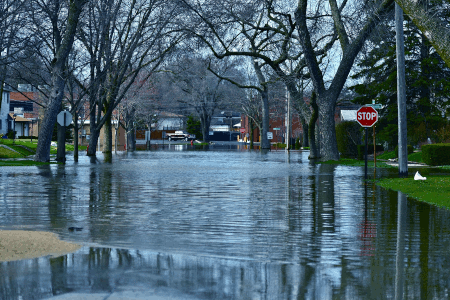Related Posts



You are about to leave Risk Strategies website and view the content of an external website.
You are leaving risk-strategies.com
By accessing this link, you will be leaving Risk Strategies website and entering a website hosted by another party. Please be advised that you will no longer be subject to, or under the protection of, the privacy and security policies of Risk Strategies website. We encourage you to read and evaluate the privacy and security policies of the site you are entering, which may be different than those of Risk Strategies.


Those living far from the ocean, a river or other typically problematic water features may think they’re safe, but new extreme storm realities mean inland properties outside of designated flood zones are at increased risk of deluge-driven surface water and flash flooding – broadly called pluvial flooding – which is not covered by homeowner’s insurance.
Often measured in multiple inches per hour, the unprecedented rainfall from these usually unnamed storms turns roads and streets into “rivers” as soil absorption and drainage systems are overwhelmed. We saw this in Oklahoma in June and July when strong storms with torrential rain hit in a very short amount of time, creating huge volumes of forceful water closing roads, rushing through the streets and into homes.
Homeowners lacking flood coverage are on the hook for the costly repairs this flooding can cause.
Insurance carriers rely on historical data to determine what risks to cover and at what price. Despite the increasing frequency of storms causing pluvial flooding, we have not yet seen increased flood insurance rates for properties outside of flood zones. But insurers are aware of this growing problem.
As pluvial flooding outside of flood zones continues to rise in frequency it will lead to large payouts for affected homeowners holding flood insurance policies in those areas. This, in turn, will cause insurance companies to recalibrate their risks and costs. They may lose their appetites for offering flood insurance in certain areas, increase rates for the coverage, or both. We have witnessed this behavior from carriers in wildfire states, where carriers are refusing coverage to homes in at-risk areas because it is not financially sustainable.
Property owners have a chance now to get ahead of this trend by closely evaluating their potential pluvial flooding risk and securing flood insurance coverage before a recalibration hits their area.
Obtain elevation certificates: Regulated by the Federal Emergency Management Agency (FEMA), an elevation certificate lists a building's location, lowest point of elevation, and flood zone adjacency. Carriers use them to determine flood insurance rates and can help property owners gain a clearer picture of their flood risk. Homeowners can usually obtain an elevation certificate from their local municipality.
Review current flood maps: Flood maps are regularly redrawn to reflect storm impact. Currently near, but not in, a designated flood zone? You may be soon. That change would significantly increase premiums for flood insurance. Securing flood insurance before you’re mapped into a flood zone will help keep your rates reasonable and eliminate the possibility of being declined.
Assess proximity to waterways: Know where your waterways and bodies of water are: rivers, lakes, reservoirs, shorelines, marshland, etc. The closer your home is, the more likely you are to experience flooding.
Connect with a consultant: A trusted risk management advisor can connect property owners with consultants that assess a property’s specific risk level based on geography, current flood maps, elevation certificates, soil types, drainage infrastructure, hardscape, and storm frequency.
With increasing severe storm frequency and changing market dynamics in mind, homeowners across the country should also consider the following in addition to property insurance coverage:
Back-up of sewers and drains insurance
Mold insurance
Water seepage and leakage insurance
Expanding flood maps and increasing incidents of pluvial flooding far outside of traditional flood zones have shown us that nowhere is safe. Risk Strategies experts offer guidance and consultation to homeowners seeking the best protection for their home. Reach out to connect.
Find me on LinkedIn, here.
Connect with the Risk Strategies Private Client team at privateclient@risk-strategies.com.
Email me directly at spincus@risk-strategies.com.
The contents of this article are for general informational purposes only and Risk Strategies Company makes no representation or warranty of any kind, express or implied, regarding the accuracy or completeness of any information contained herein. Any recommendations contained herein are intended to provide insight based on currently available information for consideration and should be vetted against applicable legal and business needs before application to a specific client.


